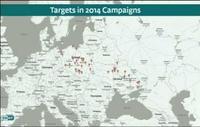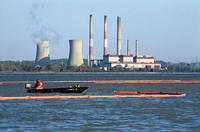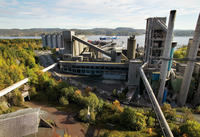-
Security experts worry BlackEnergy technology could soon be available to bad non-state actors

DHS a few days ago has issued a cyberthreat alert to critical infrastructure firms warning of the malicious software called BlackEnergy, a variant of a Trojan horse believed to have originated from Russian government-sponsored hackers. BlackEnergy is similar to another Russian issued malware called Sandworm, which was used in a 2013 Russian cyber-espionage campaign against NATO, the European Union, and overseas telecommunication and energy assets. DHS believes the attack on U.S. critical systems is “part of a broader campaign by the same threat actor.”
-
-
Gas can be a “bridge fuel” to a low-carbon future

Major new suggests that gas could play an important role as a “bridging fuel” to a low-carbon economy, but warns that it will not be long before gas becomes part of the problem rather than the solution. The research combines the latest energy system modelling techniques with analysis of U.K. gas security to assess future demand.
-
-
U.S. government networks vulnerable despite billons spent on protecting them
Experts say that cybersecurity has leaped over terrorism as the top threat to U.S. security, and with the awareness of the threat comes funding better to secure government systems. There are currently 90,000 information technology security professionals working for the government, 33 percent of them are contractors. The federal government is projected to hire more cyber professionals and spend $65 billion on cybersecurity contracts between 2015 and 2020, but today, federal cybersecurity officials are still struggling to keep sensitive data from hackers and cyber criminals. Some have warned of a “Cyber Pearl Harbor” — but Pearl Harbor was a surprise. No one in business or government today can continue to plead surprise when it comes to the possibility of cyberattack.
-
-
Information sharing is key in responding to cyberattacks
Time is not your friend when your information systems are under cyberattack, but sharing threat information before, during, and after an attack with a trusted group of peers can help. Not only does it alert the other members of your community to a potential attack, it can provide critical actionable information to speed and bolster your own defenses. Participating in a formal information sharing group can greatly enhance an organization’s cybersecurity capabilities.
-
-
Energy engineers call for new, less restrictive regulatory framework for fracking
Leading energy engineers are suggesting that U.K. regulations on the surface vibrations caused by shale gas fracking are unnecessarily restrictive. The engineers state in a new paper that widely applying restrictions similar to those currently in force on fracking would require a ban on heavy vehicles from passing houses or walking on wooden floors. They also state that the threat of serious earthquakes caused by fracking activity is considerably lower than commonly feared.
-
-
New technology reduces cost to capture carbon

The U.S. Department of Energy’s Savannah River National Laboratory (SRNL) has signed an Exclusive Rights Agreement with Partnering in Innovation, Inc. of Orlando, Florida, in support of new carbon capture technology. Originally developed at SRNL, this approach will help open global markets for cost-effective industrial carbon dioxide (CO2) capture and re-use.
-
-
Sea level rise threatens California coastal infrastructure
Officials in Humboldt County, California are preparing for sea level rise, which experts say could threaten utilities and U.S. highway 101. The National Research Councilwarns that California, Oregon, and Washington could experience twelve inches of sea level rise by 2050 and thirty-six inches by 2100. Sea level on Humboldt Bay has increased by eighteen inches over the past century due to increasing tide elevation and subsidence. Gas, electrical, and water transmission lines are all buried in the farmlands behind dikes that fortify the shoreline.
-
-
Generating fuel from sunlight
Researchers have made significant progress towards developing a process of Artificial Photosynthesis (AP) that could replace the use of fossil fuels in the future. AP is the industrial process of preparing fuels and chemicals from nothing more than carbon dioxide, water and sunlight. It is a vital process that would be the foundation of a world that would no longer need fossil fuels.
-
-
Russian government hackers insert malware in U.S. critical infrastructure control software
Investigators have uncovered a Trojan Horse named BlackEnergy in the software that runs much of the U.S. critical infrastructure. In a worst case scenario, the malware could shut down oil and gas pipelines, power transmission grids, water distribution and filtration systems, and wind turbines, causing an economic catastrophe. Some industry insiders learned of the intrusion last week via a DHS alert bulletin issued by the agency’s Industrial Control Systems Cyber Emergency Response Team(ICS-CERT). The BlackEnergy penetration had recently been detected by several companies. Experts say Russia has placed the malware in key U.S. systems as a threat or a deterrent to a U.S. cyberattack on Russian systems – mutual assured destruction from a cold war-era playbook.
-
-
As drought continues, more Californians turn to greywater
California’s rainy season tends to run from October to late March, but for the third year in a row rain has been relatively absent, meaning that the state is currently suffering from a severe, unprecedented drought. With increasing water rates, a growing number of homeowners in Southern California are relying on greywater systems to support their landscapes and toilet flushing. “If the drought continues, honestly, I could see all new construction will have greywater systems of some kind because it really doesn’t make sense to put usable water in the sewer system,” says one expert.
-
-
State, federal role in electric utilities’ labor issues should be reexamined: Study
Power outages have never been more costly. Electricity is critical to communication, transportation, commerce and national security systems, and wide-spread or prolonged outages have the potential to threaten public safety and cause millions, even billions, of dollars in damages. This is why it may be time to re-examine the role of public utility commissions and the effect of the National Labor Relations Act in labor disputes regarding electric utilities, a new study suggests.
-
-
NASA facilities across U.S. vulnerable to climate change
The National Aeronautics and Space Administration (NASA) has been at the forefront of climate science, launching satellites that take the pulse of Earth’s land, oceans, and atmospheric systems, gathering data on climate, weather, and natural hazards. The agency, however, is itself increasingly vulnerable to the effects of a changing climate. Hurricane Isabel partially flooded the Langley Research Center in Virginia in 2003; Hurricane Frances damaged the Kennedy Space Center in Florida in 2004; and Hurricane Katrina damaged buildings at the Stennis Space Center in Mississippi in 2005, among recent incidents. Other facilities have been damaged or threatened by tornadoes and wildfires.
-
-
Harnessing artificial intelligence to search for new Ebola treatments
The University of Toronto, Chematria, and IBM are combining forces in a quest to find new treatments for the Ebola virus. Using a virtual research technology invented by Chematria, a startup housed at U of T’s Impact Center, the team will use software that learns and thinks like a human chemist to search for new medicines. Running on Canada’s most powerful supercomputer, the effort will simulate and analyze the effectiveness of millions of hypothetical drugs in just a matter of weeks.
-
-
Standardizing small, self-sustaining electric microgrids
When Department of Energy and Oak Ridge National Laboratory researchers talk about “islanding,” or isolating, from the grid, they are discussing a fundamental benefit of microgrids — small systems powered by renewables and energy storage devices. The benefit is that microgrids can disconnect from larger utility grids and continue to provide power locally.
-
-
Hungarian red mud spill did little long-term damage

The aftereffects of the 2010 red mud spill that threatened to poison great swathes of the Hungarian countryside have turned out to be far less harmful than scientists originally feared. The disaster happened when weeks of heavy rain caused a dam to collapse at a containment facility in Ajka in Western Hungary. It released around a million cubic meters of toxic sludge into the Torna-Marcal river system, onto the Hungarian plain and ultimately into the Danube. The mud, a byproduct of refining aluminum from bauxite ore, was dangerously alkaline, extremely salty and contained potentially toxic metals like chromium and vanadium.
-
More headlines
The long view
Water Wars: A Historic Agreement Between Mexico and US Is Ramping Up Border Tension
As climate change drives rising temperatures and changes in rainfall, Mexico and the US are in the middle of a conflict over water, putting an additional strain on their relationship. Partly due to constant droughts, Mexico has struggled to maintain its water deliveries for much of the last 25 years, deliveries to which it is obligated by a 1944 water-sharing agreement between the two countries.
Trump Is Fast-Tracking New Coal Mines — Even When They Don’t Make Economic Sense
In Appalachian Tennessee, mines shut down and couldn’t pay their debts. Now a new one is opening under the guise of an “energy emergency.”
Smaller Nuclear Reactors Spark Renewed Interest in a Once-Shunned Energy Source
In the past two years, half the states have taken action to promote nuclear power, from creating nuclear task forces to integrating nuclear into long-term energy plans.
Keeping the Lights on with Nuclear Waste: Radiochemistry Transforms Nuclear Waste into Strategic Materials
How UNLV radiochemistry is pioneering the future of energy in the Southwest by salvaging strategic materials from nuclear dumps –and making it safe.
Model Predicts Long-Term Effects of Nuclear Waste on Underground Disposal Systems
The simulations matched results from an underground lab experiment in Switzerland, suggesting modeling could be used to validate the safety of nuclear disposal sites.
